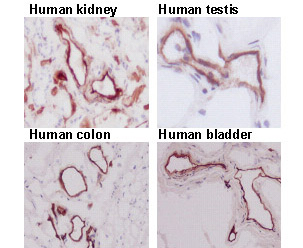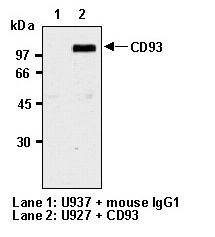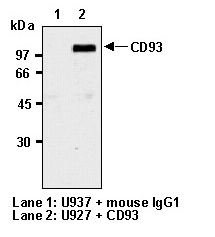Anti-CD93 (Human) mAb
| Code | Size | Price |
|---|
| MBL-D198-3 | 100 ug | £253.00 |
Quantity:
Prices exclude any Taxes / VAT
Overview
Host Type: Mouse
Antibody Isotype: IgG1
Antibody Clonality: Monoclonal
Antibody Clone: mNI-11
Regulatory Status: RUO
Target Species: Human
Applications:
- Flow Cytometry
- Immunohistochemistry (IHC)
- Immunoprecipitation (IP)
Shipping:
4°C
Storage:
-20°C
Images
Documents
Further Information
Applications:
IP - 2 ug/400 ug of cell extract from 5x106 cells FCM - 5 ug/mL (final concentration) IHC - 10 ug/mL (Frozen IH
Background:
CD93, also known as C1qRp, is a 100-125 kDa type I membrane protein that is a receptor for the complement protein C1q. CD93 has also been shown to act as a receptor for mannose-binding lectin and surfactant protein A. CD93 is expressed on the surface of monocytes, granulocytes, and endothelial cells, and expression is increased by TNF-? or GM-CSF. CD93 is involved in ligand-mediated enhancement of phagocytosis and intercellular adhesion.
Concentration:
1 mg/mL
Formulation:
100 ug IgG in 100 ul volume of PBS containing 50% glycerol, pH 7.2. Contains nopreservatives.
Gene IDs:
Human: 22918 Mouse: 17064
Immunogen Translated:
U937 cells were stimulated with LPS
Reactivity:
This antibody reacts with CD93 antigen on Immunoprecipitation, Immunohistochemistry and Flow cytometry. mNI-11 has been reported to induce intercellular adhesion of LPS-stimulated monocyte (U937) cells as well as inducing the adhesion of these cells to an endothelial (HUVEC) cell layer and rapid spread formation in HUVECs.
Shelf Life:
1 year
Source:
This antibody was purified from hybridoma (clone mNI-11) supernatant using protein A agarose. This hybridoma was established by fusion of mouse myeloma cell P3U1 with Balb/c mouse splenocyte immunized with LPS-stimulated U937.
Target:
CD93
References
1)
Ikewaki, N
.,
et al
.,
Microbiol
.
Immunol.
57
, 822
-
8
32 (2013)
2)
Ikewaki, N
.,
et al
.,
J
.
Clin
.
Immunol
.
30
,
723
-
7
33
(
2010
)
3)
Ikewaki, N.,
et al
.,
Microbiol. Immunol.
51
, 1189
-
1200 (2007)
4)
Ikewaki, N.,
et al
.,
Microbiol. Immunol.
50
, 93
-
103 (2006)
5)
Ikewaki, N.,
et al., J. of Kyushu Univ. of Health and
Welfare
7
, 183
-
189 (2006)
6)
McGreal, E. P.,
et al.
, J. Immunol
.
168
, 52
22
-
5232 (
2002
)
7)
Ikewaki, N.,
et al.
, J. Clin. Immunol
.
20
, 317
-
324
(
2000
)
8)
Ikewaki, N.,
and Inoko, H.,
J. Leukoc.
Biol
.
59
, 697
-
708
1)
Ikewaki, N
.,
et al
.,
Microbiol
.
Immunol.
57
, 822
-
8
32 (2013)
2)
Ikewaki, N
.,
et al
.,
J
.
Clin
.
Immunol
.
30
,
723
-
7
33
(
2010
)
3)
Ikewaki, N.,
et al
.,
Microbiol. Immunol.
51
, 1189
-
1200 (2007)
4)
Ikewaki, N.,
et al
.,
Microbiol. Immunol.
50
, 93
-
103 (2006)
5)
Ikewaki, N.,
et al., J. of Kyushu Univ. of Health and
Welfare
7
, 183
-
189 (2006)
6)
McGreal, E. P.,
et al.
, J. Immunol
.
168
, 52
22
-
5232 (
2002
)
7)
Ikewaki, N.,
et al.
, J. Clin. Immunol
.
20
, 317
-
324
(
2000
)
8)
Ikewaki, N.,
and Inoko, H.,
J. Leukoc.
Biol
.
59
, 697
-
708
1)
Ikewaki, N
.,
et al
.,
Microbiol
.
Immunol.
57
, 822
-
8
32 (2013)
2)
Ikewaki, N
.,
et al
.,
J
.
Clin
.
Immunol
.
30
,
723
-
7
33
(
2010
)
3)
Ikewaki, N.,
et al
.,
Microbiol. Immunol.
51
, 1189
-
1200 (2007)
4)
Ikewaki, N.,
et al
.,
Microbiol. Immunol.
50
, 93
-
103 (2006)
5)
Ikewaki, N.,
et al., J. of Kyushu Univ. of Health and
Welfare
7
, 183
-
189 (2006)
6)
McGreal, E. P.,
et al.
, J. Immunol
.
168
, 52
22
-
5232 (
2002
)
7)
Ikewaki, N.,
et al.
, J. Clin. Immunol
.
20
, 317
-
324
(
2000
)
8)
Ikewaki, N.,
and Inoko, H.,
J. Leukoc.
Biol
.
59
, 697
-
708
(
1996
)








